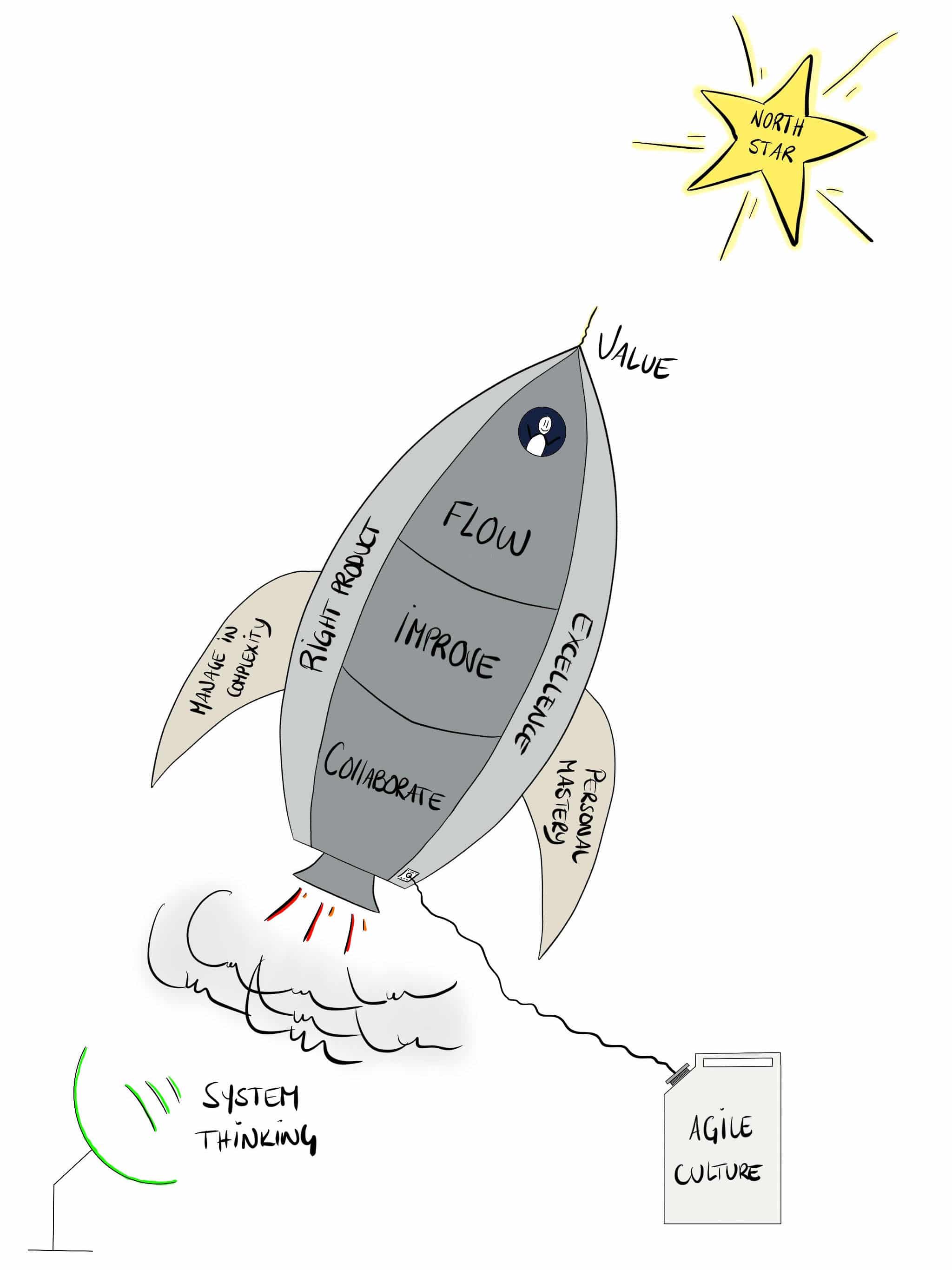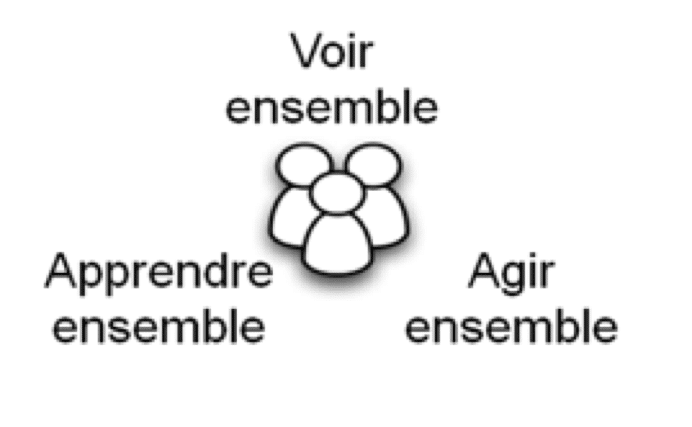
Agile Rocket – Illustration par Nicolas Verdot
L’Agile Rocket est la démarche d’accompagnement modulaire, progressive et respectueuse décrite lors du Boooksprint réalisé fin d’année dernière avec 4 collègues de Goood. Suite à la série d’articles sur la forme, voici une série d’articles sur le fond décrivant un exemple de mise en oeuvre concret de certains modules.
Aujourd’hui, ce sera le module Management Visuel ! 🙂
Contexte d’étude
En fin d’année dernière, j’ai échangé avec une manager (hors IT) sur les problématiques qu’elle rencontrait au sein de son équipe. Elle venait de prendre ses fonctions il y a quelques mois et ressentait un certain mal-être des personnes auquel elle avait à coeur de répondre. Manque de visibilité, surcharge, manque de collaboration et de communication… voici les termes que j’entends au cours de notre discussion.
Je lui propose alors de l’aider à créer une dynamique de collaboration en lui décrivant les objectifs du premier module de l’Agile Rocket :
- transformer une somme d’individualités en un collectif
- s’appuyer sur ce collectif pour prendre les bonnes décisions
Pour ce faire, nous nous appuierons sur la mise en oeuvre d’un management visuel permettant à l’équipe de :

Le cadre proposé
L’intérêt de la démarche est de rendre l’effort nécessaire par l’ensemble des parties le plus transparent possible. Ainsi, j’ai présenté la structure d’accompagnement suivante basée sur 6 workshops d’une demi-journée :
Sensibilisation au Management Visuel

Workshop 1 : Kick-off
Intention : poser les bases de collaboration
- Quel est l’état à aujourd’hui de la situation ?
- Quel est l’objectif à atteindre ?
- Quel est le rôle du coach ?
- Qu’est-ce qu’un accompagnement Management Visuel ?
- A quoi est-ce que je m’engage personnellement à faire pour l’équipe dans cet accompagnement ?
- …
Cette liste n’est bien sûr pas exhaustive mais peut vous donner une ligne directrice.
J’avais décrit ce workshop dans un précédent article : « Structure de Kick-off d’une demi-journée »
Workshop 2 : Management Visuel
Intention : sensibiliser à la notion de Management Visuel
Le workshop a été découpé en 2 parties :
- Une partie formation entre 30 mn et 1 h,
- Une partie expérimentation avec l’atelier « Au Tableau » d’Alexandre Boutin sur environ 1h30.
L’objectif est de faire prendre conscience aux participants de la puissance du Management Visuel, de ses usages et des bénéfices qu’ils pourraient en retirer.
Note : Le fait de ne pas rentrer dans le concret tout de suite est une manière de faire assimiler les notions aux participants sans s’encombrer des contraintes de leur contexte.
Mise en pratique sur le terrain

Workshop 3 : Mise en oeuvre (partie 1)
Intention : initier un premier management visuel et faire pratiquer le Daily Meeting
L’essentiel du workshop est centré sur la construction d’un premier Management Visuel mais l’objectif ici est double :
- travailler sur le fond (contenu) pour obtenir un résultat utilisable en sortant de workshop
- travailler sur la forme (processus) pour déjà faire collaborer les participants ensemble dans la construction de leur outil
On présente de plus le fonctionnement du Daily Meeting afin de pouvoir actionner la dynamique jusqu’au prochain workshop. En effet, même si je n’ai pas pour habitude d’imposer des choses, cela fait partie des éléments que je demande à l’équipe d’expérimenter pendant une semaine de manière à pouvoir véritablement pratiquer.
J’ai décrit ce workshop dans l’article suivant : « Module Management Visuel : Mise en oeuvre (Partie 1) »
Workshop 4 : Mise en oeuvre (partie 2)
Intention : améliorer le management visuel existant
Suite à l’expérimentation de l’équipe de leur version de management visuel, ce workshop est l’occasion de pouvoir prendre du recul et l’améliorer au besoin.
Plusieurs axes peuvent être étudiés :
- Améliorer : système de couleurs, typologie de tickets, lignes de nage…
- Étendre : processus amont, processus aval, responsabilités selon l’activité du processus…
- Zones : équipe, métriques, objectifs…
L’objectif étant une nouvelle fois sur le fond ET la forme afin de permettre à l’équipe de s’approprier le plus possible leur nouvel outil de travail.
J’ai décrit ce workshop dans l’article suivant : « Module Management Visuel : Mise en oeuvre (Partie 2)«
Suivi

Workshop 5 : Libre
Intention : échanger autour des problématiques rencontrées par l’équipe
Après avoir laissé un temps plus important d’expérimentation autonome, ce workshop a véritablement pour but d’échanger sur les problématiques rencontrées par l’équipe.
Ce workshop peut être séparé en 2 parties :
- Questions / Réponses
- Apport de notions supplémentaires
Note : cela nécessite ainsi une certaine flexibilité dans l’animation car on ne connaît pas vraiment le contenu à l’avance !
Clôture
Workshop 6 : Rétrospective
Intention : prendre du recul sur le chemin parcouru
Comme toute rétrospective, l’objectif de ce dernier workshop est de regarder en arrière et de conscientiser les apprentissages de l’équipe.
C’est une bonne occasion pour revenir sur :
- les objectifs, engagements exprimés lors du Kick-off
- le ressenti de chacun pendant l’accompagnement
- les bénéfices obtenus
J’ai décrit ce workshop dans l’article suivant : « Module Management Visuel : Rétrospective et clôture »
Rythme

Les Workshops 1 à 4 sont espacés d’une semaine afin de maintenir un rythme suffisamment soutenu au début.
Le Workshop 5 vient en support après un mois d’expérimentation autonome de l’équipe.
Le Workshop 6 clôture l’accompagnement, un mois plus tard, en capitalisant sur les apprentissages et en projetant l’équipe sur les étapes suivantes.
Conclusion
La description du cadre proposé pour cet accompagnement est un exemple de ce qui peut être fait lors de la mise en place d’un module Management Visuel. Il a le bénéfice d’être clair dès le départ en terme d’investissement, que ce soit pour l’équipe mais également pour le coach.
L’approche est caractérisée par un apprentissage sur le terrain et un apport de théorique au fil de l’eau allégeant ainsi l’effort pour l’ensemble des parties. On se focalise ainsi sur l’apport maximal de valeur sur un laps de temps fixé : cela ne vous rappelle pas quelque chose ? 😉
Une description plus précise des workshops 3, 4 et les résultats obtenus dans la rétrospective du contexte étudié feront l’objet des prochains articles !







